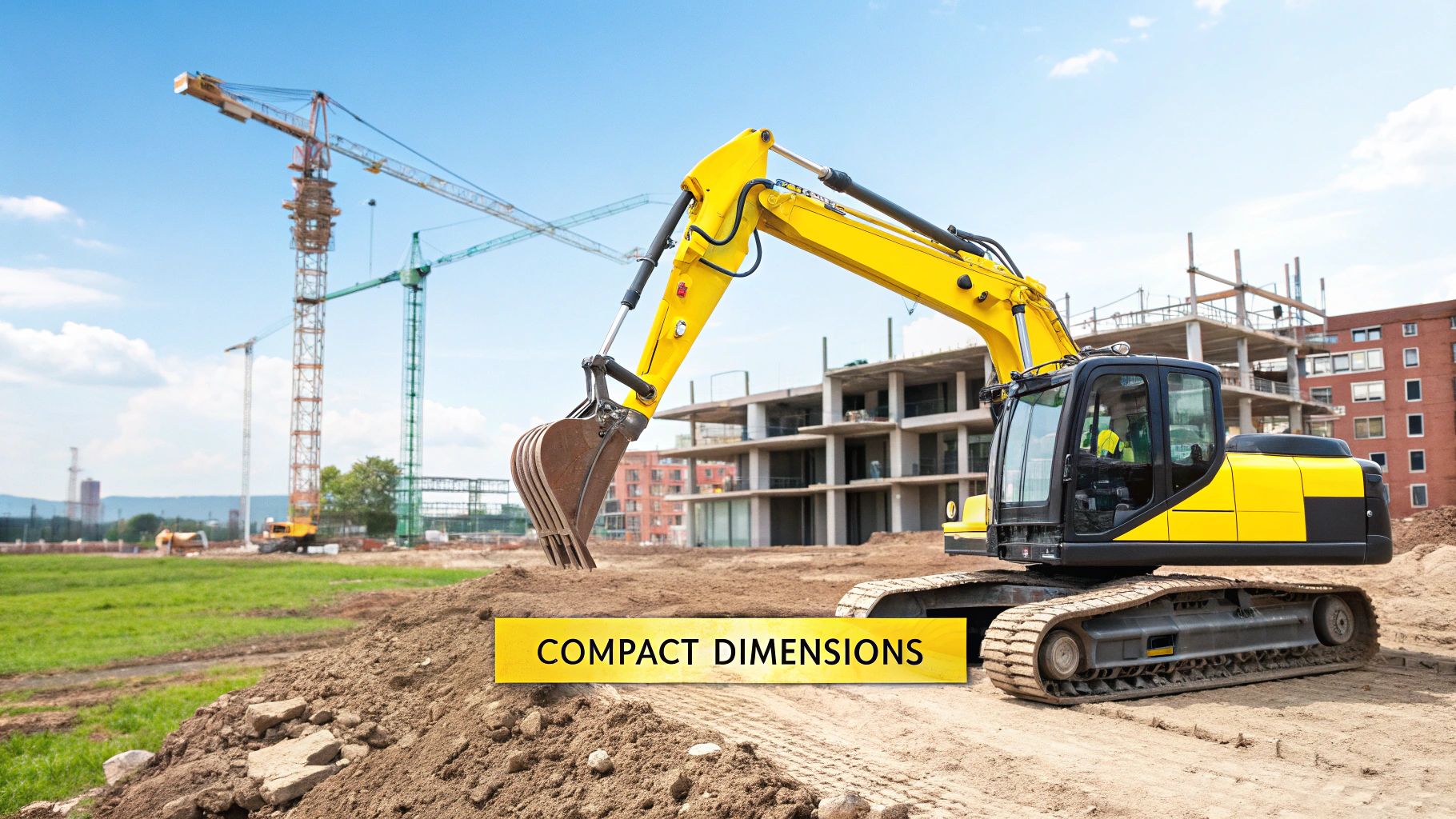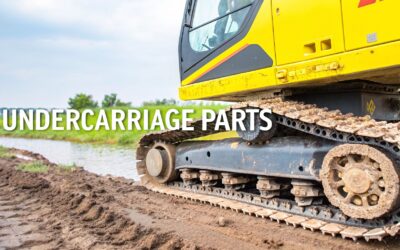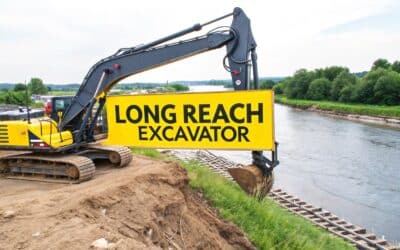The John Deere 210G isn't just another mid-size excavator; it's a workhorse known for striking a practical balance between raw power and on-the-job efficiency. At its core is a John Deere PowerTech PSS 4.5L engine that puts out a solid 159 net horsepower. This combination of a robust powertrain and a responsive hydraulic system makes it a go-to machine for everything from demanding construction projects to specialized environmental cleanup. Understanding the key specifications is crucial for any project manager looking to maximize productivity and ROI.
An Overview Of The John Deere 210G Excavator
In the world of 20-ton class excavators, the John Deere 210G has carved out a strong reputation for reliability and performance. When selecting a machine in this category, decision-makers need equipment that is not just powerful, but also efficient and dependable, as project success often hinges on it. Getting familiar with the core john deere 210g specs is the essential first step for anyone considering this machine for demanding work like pipeline installation, dredging, or land reclamation.
The 210G is engineered on a solid foundation, built to handle both standard earthmoving and challenging, heavy-duty modifications, making it a versatile asset for any fleet.
The PowerTech engine is the heart of the machine, providing the muscle needed for heavy digging, lifting, and cycling, day in and day out, which is especially critical in challenging amphibious environments.
For a quick reference, here are the standout numbers for the 210G.
John Deere 210G Key Specifications at a Glance
| Specification | Metric |
|---|---|
| Net Power | 159 hp (119 kW) |
| Operating Weight | 47,736 lbs (21,653 kg) |
| Max Digging Depth | 21 ft 11 in (6.68 m) |
| Max Digging Reach | 32 ft 4 in (9.86 m) |
| Arm Digging Force | 25,179 lbf (112 kN) |
| Bucket Digging Force | 31,697 lbf (141 kN) |
This table provides the vital statistics at a glance, but the real story is how these numbers translate to performance on the ground and in challenging terrains like wetlands or swamps.
Key Performance Characteristics
The 210G is engineered to perform reliably across a wide range of job site conditions. These specs represent real-world advantages that translate to project success.
- Balanced Power and Efficiency: The engine and hydraulic system are perfectly matched. This synergy delivers the digging force you need without burning through fuel unnecessarily, a significant factor in managing project costs.
- Operator-Focused Design: John Deere put significant thought into the cab. The controls are intuitive and the environment is designed to minimize operator fatigue, a crucial factor for maintaining productivity and safety over long shifts.
- Adaptable Platform: Thanks to its strong frame and powerful systems, the 210G is an excellent base for specialized modifications. It's a popular choice for conversions into amphibious excavators, which are essential for industries like environmental remediation and pipeline maintenance in wetlands.
It's also worth noting that the integrity of industrial machinery like this extends down to the smallest details, such as the permanent component identification achieved through processes like laser engraving metal.
Engine Power and Emissions Compliance
At the core of the John Deere 210G sits its PowerTech PSS 4.5L engine, a true workhorse built for demanding applications. It produces a solid 159 horsepower (119 kW) net, providing the raw strength needed for heavy digging, lifting, and the constant cycling that challenging sites require. That’s the kind of power that lets an operator confidently tear into dense soil or manage heavy materials all day long.
Of course, horsepower is just one number on a spec sheet. What really matters on the job is how that power translates to performance. This engine is designed to deliver consistent torque across its entire operating range. That means it can handle sudden, heavy loads without bogging down or stalling, a critical advantage when you're trenching for a pipeline or clearing land for a reclamation project.
Performance Meets Environmental Standards
A major factor in the John Deere 210G specs is how it balances that power with today's strict environmental regulations. The PowerTech engine is fully compliant with EPA Final Tier 4 emissions standards, which is a non-negotiable requirement for many projects. It achieves this using a sophisticated system of cooled exhaust gas recirculation (EGR), a diesel oxidation catalyst (DOC), and selective catalytic reduction (SCR).
For project managers and fleet owners, this is more than just a technical detail. It means the 210G can legally operate on sites with the tightest environmental rules, helping you avoid costly fines and unexpected project shutdowns.
The best part is that this advanced emissions system doesn't sacrifice performance or fuel economy. It’s a well-engineered solution that lets the 210G remain a powerful, efficient machine while also being a responsible choice for work in sensitive areas like wetland restoration or urban development.
Understanding Hydraulic System Performance
Think of an excavator's hydraulic system as its heart and muscles. It's what gives the machine its brute strength for digging and its fine control for delicate tasks. The John Deere 210G is built with a powerful, responsive system designed to keep up with demanding job site conditions, whether on land or in water.
At the core are two variable-displacement axial-piston pumps. Together, they push out a massive 111 gallons per minute (420 L/m). This high flow rate is the secret behind the 210G's ability to multitask without breaking a sweat. You can swing the cab and lift the boom simultaneously without seeing a drop in performance. For high-volume jobs like dredging or truck loading, that fluid motion saves valuable time and improves efficiency.
Interpreting Hydraulic Power and Cycle Times
So, what does all that flow and pressure mean in the real world? It translates directly to faster cycle times, which is a key metric for productivity on any site. Faster cycles mean more material moved per hour, keeping your project on track and on budget. The john deere 210g specs really shine here, offering the kind of snappy, predictable movements that experienced operators appreciate for precision work.
For example, a quick hitch raise only takes 1.7 seconds, and the loader boom reaches its full height in just 4.7 seconds. This speed is invaluable when you're constantly handling materials. Pair that speed with a main relief pressure of 4,975 psi (34,300 kPa), and you have the raw breakout force needed to tear through tough, compacted ground or rocky soil. You can dig deeper into its operational capabilities in the official John Deere product guide.
Operating Weight, Dimensions, and Transport Logistics
When planning a project, the operating weight is one of the most critical specifications. For the John Deere 210G, that number is a hefty 47,736 lbs (21,653 kg). This figure dictates everything from the type of trailer you'll need for transport to how the machine will perform on soft ground.
Project managers know this weight is fundamental for site planning. It's the basis for calculating ground pressure to avoid damaging sensitive surfaces and ensuring the machine won't get bogged down in unstable soil. This is especially true for wetland projects, where ground pressure can make or break an operation.
These specs are also the starting point for any serious modifications. When we at Wilco Manufacturing design an amphibious undercarriage for a 210G, we start with a deep analysis of its weight distribution and dimensions. This data is crucial for engineering a custom pontoon system that delivers the right buoyancy and keeps the machine stable and productive in wetlands or on waterways.
From Standard to Specialized Applications
Weight is always a balancing act, even for smaller machines. Take a John Deere tractor loader, for example, which might have an operating weight around 5,334 kg (11,760 lbs). It’s engineered to be light enough for easy maneuvering but heavy enough to stay planted and durable.
You can see how this principle applies across different machine types by looking at these John Deere equipment details. Ultimately, whether it's a standard excavator or a highly modified amphibious rig, the art of heavy equipment design is all about striking that perfect balance between weight, power, and function.
Digging Forces and Lifting Capacities: On-the-Job Reality
When it comes down to it, an excavator's true worth is measured by what it can pull out of the ground and what it can lift. For the John Deere 210G, the numbers prove this machine is a serious contender for heavy-duty earthmoving.
We’re talking about an arm digging force of 25,179 lbf (112 kN) and an even more impressive bucket digging force of 31,697 lbf (141 kN). These aren't just abstract specs. They translate directly to the machine's real-world ability to rip through tough, compacted soil or rocky ground without bogging down. It’s what keeps a project moving forward when conditions get tough.
This kind of raw power is absolutely essential for deep excavation projects, whether you're laying pipelines in challenging soil or dredging sediment from a waterway. An operator knows they can confidently tackle challenging materials and keep the project on schedule.
Turning Brute Force into Finesse
Digging is only half the battle. An excavator’s lifting capacity is what makes it a master of site logistics, and this is where the 210G really shows its versatility. It's built to safely lift and precisely place heavy items like concrete pipes, trench boxes, and large mats.
The loader's breakout force is a solid 42.3 kN (9,521 lbs), a figure that points to its strength in both digging and prying up heavy loads. The lift capacity tops out at 2,876 kg (6,340 lbs). You can dig deeper into these performance specs in this John Deere technical document.
A quick word of caution: knowing these limits is non-negotiable for safe operation. Pushing past the rated lifting capacity is a sure way to damage the equipment and, more importantly, create a massive safety risk for everyone on site.
Understanding how to apply these forces is particularly critical in specialized work. For instance, our custom amphibious excavators depend on the 210G’s lifting power to manage heavy attachments for our unique equipment for dredging. That power ensures we get stable, effective performance, even in difficult marine environments.
Taking the 210G from Solid Ground to Swamplands
The impressive specs of the John Deere 210G aren't just for solid ground. That same robust frame, powerful hydraulic system, and reliable engine make it an excellent candidate for amphibious conversions, turning a top-tier excavator into a machine that can master wetlands, swamps, and waterways. This modification is a game-changer for industries that work in environmentally sensitive or inaccessible areas.
The secret lies in leveraging the 210G's built-in strengths. Its substantial operating weight provides a stable platform, and its hydraulic power is more than enough to drive a specialized undercarriage. The conversion involves swapping the standard tracks for custom-engineered pontoons, giving the machine the buoyancy it needs to float and maneuver in challenging aquatic environments.
How the Amphibious Conversion Works
This kind of modification creates a high-performance amphibious excavator that can take on jobs completely inaccessible to standard equipment. A successful conversion is all about the undercarriage design, it has to perfectly balance the 210G's weight while providing consistent, reliable propulsion through water and mud.
When done right, an amphibious conversion turns what would be a logistical nightmare into a manageable project. Suddenly, you can get into previously unreachable areas for crucial work like dredging, shoreline restoration, or pipeline maintenance without the massive expense of building temporary access roads or causeways. This directly translates to lower project costs and reduced environmental impact.
As experts in engineering these custom solutions, Wilco Manufacturing starts with the 210G's core specifications to design and build amphibious hydraulic undercarriages that integrate directly with the excavator's factory systems. The final product isn't just a machine with pontoons bolted on; it's a fully functional, purpose-built amphibious tool ready to tackle the toughest wetland jobs.
Your Questions Answered: The John Deere 210G
When you're looking at the specs for a machine like the John Deere 210G, the numbers on the page only tell part of the story. Fleet managers and project supervisors always have a few key questions about how those specs translate to real-world performance, logistics, and even potential modifications. Let's break down some of the most common ones.
What Are the Real Advantages of the 210G's Hydraulic System?
The hydraulic system on the 210G is all about a smart blend of power, speed, and fine control. The biggest benefits you'll see on the job are its fast cycle times, which directly translate to more dirt moved per hour, and its high system pressure. That high pressure is what gives you the serious breakout force needed to slice through tough, compacted ground.
This isn't just about brute force, though. The system provides operators with smooth, predictable movements, making it just as capable at delicate grading or carefully placing utilities as it is at bulk excavation. It’s that versatility that makes it such a workhorse.
How Does the 210G's Operating Weight Impact Performance and Transport?
The operating weight of the 210G hits a sweet spot between stability and mobility. Its substantial mass creates an incredibly solid base, which is crucial for safety and confidence when you're lifting heavy loads or digging at full reach. You get a planted, stable machine that won't feel tippy.
When it comes to moving it, the 210G's weight class is a major logistical advantage. It's heavy enough for serious work but still manageable enough to be transported between job sites using standard heavy-haul trailers. This helps you avoid the permits, specialized equipment, and higher costs that come with moving oversized machines.
Can You Use a Standard 210G for Dredging?
Right out of the box, a standard 210G is built for solid ground. However, its powerful hydraulics and rugged construction make it an ideal platform for amphibious conversion. By swapping the standard tracks for a specialized pontoon undercarriage, the 210G "upper" is transformed into a highly capable dredging and wetland machine.
This modification allows it to navigate and work effectively in swamps, marshes, and shallow water, places where a conventional excavator simply can't go. It's a popular choice for everything from environmental remediation to shoreline restoration projects.
Of course, beyond the machine's capabilities, proper upkeep is key. For those looking for a broader understanding of equipment care, guides on heavy equipment servicing can provide useful context. And if your project requires working in these challenging wet environments, you can see examples of our amphibious excavators for rent.
The John Deere 210G is a formidable machine on its own, but its true potential is unlocked when adapted for specialized environments. For projects that demand conquering tough terrains from wetlands to swamps, Wilco Manufacturing has the expertise to adapt powerful machines like the 210G for amphibious operations. Contact us today to discuss your unique project needs and learn how our solutions can provide a competitive edge.



